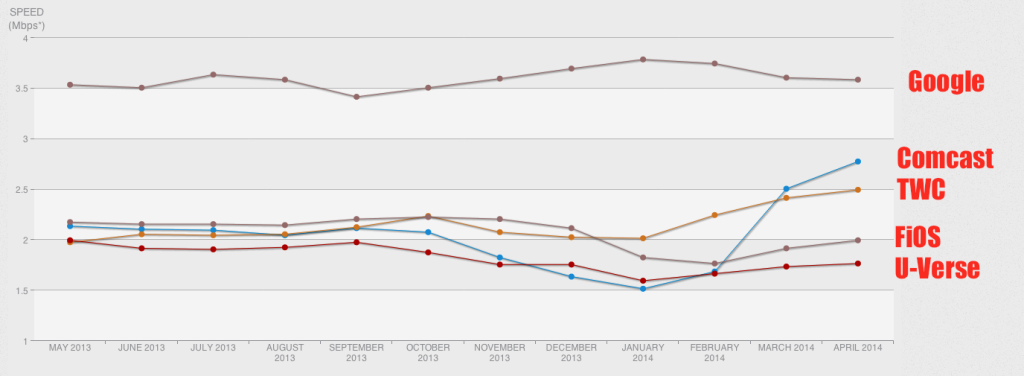What A Difference A Payoff Makes: Comcast Customers Now Seeing Decent Netflix Speeds
 Nearly three months ago, Comcast and Netflix revealed that after months of rapidly degrading data speeds for Netflix subscribers on Comcast’s network, the streaming video company and the country’s largest ISP had reached a deal where Netflix would pay for more direct access to the Comcast network. In the short time since, Comcast has jumped from the rear of the pack to near the front.
Nearly three months ago, Comcast and Netflix revealed that after months of rapidly degrading data speeds for Netflix subscribers on Comcast’s network, the streaming video company and the country’s largest ISP had reached a deal where Netflix would pay for more direct access to the Comcast network. In the short time since, Comcast has jumped from the rear of the pack to near the front.
Netflix has released its latest comparison of the downstream speeds its customers receive from various ISPs, and in the short time since Comcast speeds bottomed out at the barely watchable 1.51 Mpbs back in January, they have nearly doubled to 2.77 Mbps. This makes Comcast the third-fastest major ISP in the U.S. (behind Cablevision and Cox) and the fourth-fastest when you include Google Fiber. These are also faster speeds than Comcast customers have ever seen in the time that Netflix has been publicly posting this data.
Verizon FiOS customers are still seeing cripplingly slow speeds, though that will likely change following last week’s news that Netflix and Verizon had ironed out a paid-peering deal like the one made with Comcast.
The ISPs claim they did not deliberately degrade Netflix’s data in order to push the company into paying for these direct connections, but others — like bandwidth biggie Cogent — have said that Comcast and Verizon’s passive-aggressive refusal to upgrade or improve their connections to Netflix’s bandwidth providers had the same effect as actively throttling the stream.
Comcast and Verizon say that since Netflix is responsible for so much of the downstream data, it should have to pay more. Opponents of these deals say that if an ISP is going to market its product to consumers as delivering “the fastest Internet,” like both of these ISPs have done, then the should be doing everything they can to deliver what they promise.
Meanwhile, Netflix has announced that new customers will be seeing a $1/month price hike, purportedly to cover the increased cost of obtaining content.
Want more consumer news? Visit our parent organization, Consumer Reports, for the latest on scams, recalls, and other consumer issues.

